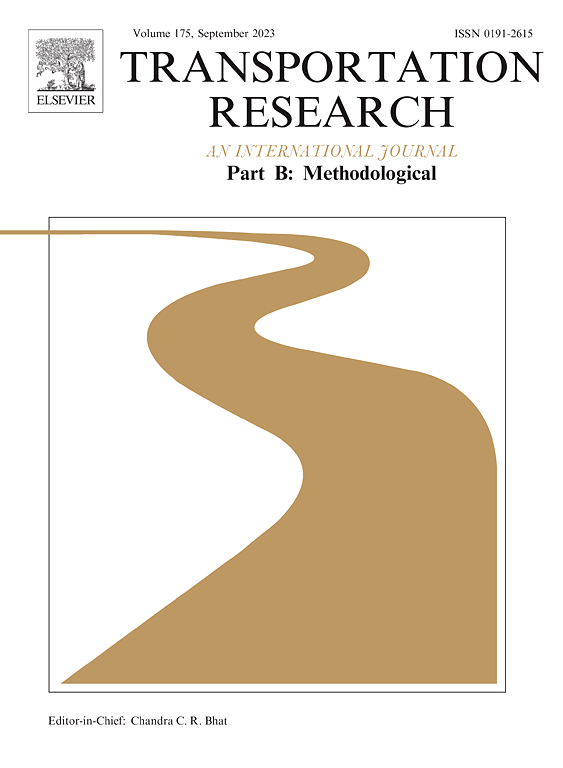Combining time dependency and behavioral game: A Deep Markov Cognitive Hierarchy Model for human-like discretionary lane changing modeling
IF 5.8
1区 工程技术
Q1 ECONOMICS
引用次数: 0
Abstract
Human drivers take discretionary lane changes when the target lane is perceived to offer better traffic conditions. Improper discretionary lane changes, however, lead to traffic congestion or even crashes. Considering its significant impact on traffic flow efficiency and safety, accurate modeling and prediction of discretionary lane-changing (LC) behavior is an important component in microscopic traffic analysis. Due to the interaction process and driver behavior stochasticity, modeling discretionary lane-changing behavior is a non-trivial task. Existing approaches include rule-based, utility-based, game-based, and data-driven ones, but they fail to balance the trade-off between modeling accuracy and interpretability. To address this gap, we propose a novel model, called Deep Markov Cognitive Hierarchy Model (DMCHM) which combines time dependency and behavioral game interaction for discretionary lane-changing modeling. Specifically, the lane-changing interaction process between the subject vehicle and the following vehicle in the target lane is modeled as a two-player game. We then introduce three dynamic latent variables for interaction aggressiveness, cognitive level, and payoffs based on the Hidden Markov Model. The proposed DMCHM combines time dependency together with cognitive hierarchy behavioral games while preserving model interpretability. Extensive experiments on three real-world driving datasets demonstrate that DMCHM outperforms other game-theoretic baselines and has comparable performance with state-of-the-art deep learning methods in time and location errors. Besides, we employ SHAP values to present the model interpretability. The analysis reveals that the proposed model has good performance in discretionary LC prediction with high interpretability. Finally, we conduct an agent-based simulation to investigate the impact of various driving styles on macroscopic traffic flows. The simulation shows that the existence of massive aggressive drivers can increase traffic capacity because of small gaps during car-following, but inversely decrease discretionary LC rates. A balanced mixing of conservative and aggressive driving styles promotes discretionary LC frequencies since conservative car-following behaviors provide more spaces for LC. The codes can be found at https://github.com/zeonchen/DMCHM.
时间依赖性与行为游戏相结合:用于类人酌情变道建模的深度马尔可夫认知层次模型
人类驾驶员在认为目标车道的交通状况更好时,会酌情变更车道。然而,不恰当的随意变道会导致交通拥堵甚至撞车。考虑到随意变道(LC)行为对交通流效率和安全的重大影响,对其进行精确建模和预测是微观交通分析的重要组成部分。由于交互过程和驾驶员行为的随机性,对随意变道行为建模是一项艰巨的任务。现有的方法包括基于规则、基于效用、基于游戏和数据驱动的方法,但这些方法未能在建模准确性和可解释性之间取得平衡。为了弥补这一不足,我们提出了一种名为 "深度马尔可夫认知层次模型"(DMCHM)的新型模型,该模型结合了时间依赖性和行为游戏交互性,可用于随意变道建模。具体来说,目标车道上的主体车辆与后续车辆之间的变道互动过程被建模为双人博弈。然后,我们在隐马尔可夫模型的基础上引入了交互攻击性、认知水平和报酬三个动态潜变量。所提出的 DMCHM 将时间依赖性与认知层次行为博弈相结合,同时保留了模型的可解释性。在三个真实世界驾驶数据集上进行的广泛实验表明,DMCHM 的表现优于其他博弈论基线,在时间和位置误差方面与最先进的深度学习方法性能相当。此外,我们还利用 SHAP 值来呈现模型的可解释性。分析表明,所提出的模型在自由裁量 LC 预测方面具有良好的性能和较高的可解释性。最后,我们进行了基于代理的模拟,以研究各种驾驶方式对宏观交通流的影响。模拟结果表明,大量激进驾驶者的存在会因跟车过程中的小间隙而增加交通容量,但会反向降低自由裁量低速行驶率。保守型和激进型驾驶风格的均衡混合会促进随意低速行驶频率,因为保守型跟车行为为低速行驶提供了更多空间。代码见 https://github.com/zeonchen/DMCHM。
本文章由计算机程序翻译,如有差异,请以英文原文为准。
求助全文
约1分钟内获得全文
求助全文
来源期刊
CiteScore
12.40
自引率
8.80%
发文量
143
审稿时长
14.1 weeks
期刊介绍:
Transportation Research: Part B publishes papers on all methodological aspects of the subject, particularly those that require mathematical analysis. The general theme of the journal is the development and solution of problems that are adequately motivated to deal with important aspects of the design and/or analysis of transportation systems. Areas covered include: traffic flow; design and analysis of transportation networks; control and scheduling; optimization; queuing theory; logistics; supply chains; development and application of statistical, econometric and mathematical models to address transportation problems; cost models; pricing and/or investment; traveler or shipper behavior; cost-benefit methodologies.

 求助内容:
求助内容: 应助结果提醒方式:
应助结果提醒方式:


